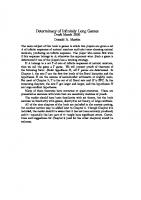Determinacy of Infinitely Long Games (draft - March 2020)
268 50 2MB
English Pages 547 [548] Year 2020
1 Elementary Methods
2 General Borel Games
3 Measurable Cardinals
4 (Π_1)^1 Games
5 α-(Π_1)^1 Games
6 Woodin Cardinals
7 Iteration Trees
8 Projective Games
9 Games in L(R)
Bibliography
Recommend Papers

- Author / Uploaded
- Donald A. Martin
- Similar Topics
- Mathematics
- Logic
- Commentary
- https://www.math.ucla.edu/~dam/booketc/thebook.pdf
File loading please wait...
Citation preview
Determinacy of Infinitely Long Games Draft March 2020 Donald A. Martin The main subject of this book is games in which two players are given a set A of infinite sequences of natural numbers and take turns choosing natural numbers, producing an infinite sequence. The player who moves first wins if this sequence belongs to A; otherwise the opponent wins. Such a game is determined if one of the players has a winning strategy. If A belongs to a set Γ of sets of infinite sequences of natural numbers, then we call the game a Γ game. We will present proofs of theorems of the following form: Under hypothesis H, all Γ games are determined. In Chapter 1, the sets Γ are the first few levels of the Borel hierarchy and the hypotheses H are the axioms of second-order arithmetic or slightly more. For most of Chapter 2, Γ is the set of all Borel sets and H is ZFC. In the remaining chapters, the sets Γ get larger and larger, and the hypotheses H are large cardinal hypotheses. Many of these theorems have converses or quasi-converses. These are presented as exercises with hints that are essentially sketches of proofs. The reader should have basic familiarity with set theory, but the book assumes no familiarity with games, descriptive set theory, or large cardinals. All of the nine chapters of the book are included in the current posting, but another section may be added later to Chapter 5. Though Chapter 9 is included, the reader should be aware that it has not been seriously proofread, and it—especially the last part of it—might have significant errors. Corrections and suggestions for Chapter 9 (and for the other chapters) would be welcome.
Chapter 1 Elementary Methods In this chapter we introduce the basic concepts of our subject and prove as much determinacy as, roughly speaking, can be proved without appealing to the existence of infinite sets larger than the sets of legal positions in our games. Readers interested primarily in the main results may wish to read just the introductory Section 1.1 and the basic Section 1.2, where the determinacy of open games is proved. The proofs in §1.1 and §1.2 do not really need the Power Set or Replacement Axioms of set theory, though this fact is not mentioned in those sections. In §1.3 and in much of §1.4, we explicitly work in a set theory without the Power Set Axiom and with only a fragmentary Replacement Axiom (adopted mostly to avoid complexities). We try to do this in a sufficiently unobtrusive way that readers unfamiliar with axiomatic set theory should be able to follow the proofs as ordinary proofs. In §1.4 we discuss the optimal determinacy result for this theory, due to Antonio Montalban and Richard Shore. In a slightly stronger theory, we prove the determinacy of all ∆04 games (games that are both Gδσδ and Fσδσ ). In the exercises we discuss Harvey Friedman’s methods, which show that the determinacy of all Σ04 games is not provable in the usual ZFC set theory if the Power Set Axiom is dropped, and we mention an improvement by Montalban and Shore showing the optimality of their positive results. Later (in §2.3) we will use the results from §1.4 in analyzing level by level how much of the Power Set and Replacement Axioms is needed for our proof of the determinacy of Borel games. 1
2
1.1
CHAPTER 1. ELEMENTARY METHODS
Basic Definitions
We begin by discussing rules of play of our games and afterward take up such matters as winning, winning strategies, and determinacy. Plays of our games will be finite or infinite sequences of moves. Rules of play are given by specifying a game tree. A game tree is a nonempty tree of finite sequences, i.e. is a set T of finite sequences such that if p ∈ T and p extends q then q ∈ T . Members of T are called legal positions in T or simply positions in T . When there is no danger of confusion, we will call them legal positions or positions. A position in T is terminal in T if it has no proper extension in T . If p is a non-terminal position, then a legal move at p in T or simply a move at p in T is an a such that p_ hai ∈ T , where _ is the concatenation operation on sequences. A play in T is a finite or infinite sequence every initial part of which belongs to T and which is a terminal position in T if finite. All our games will have two players, I and II. (“I” and “II” are not very imaginative names, but they have become traditional.) Play of a game in T begins at the initial position (the empty sequence ∅, which must belong to every game tree). I moves first, and moves alternate between the two players. Thus a play of a game is produced as follows: I II
a0
a2 a1
a4 a3
... ...
Each ha0 , a1 , . . . , an i must be a position in T . If a terminal position is reached, then we have a play of the game and no further moves are made. If no terminal position is reached, then the play is infinite. There are various ways in which we could have chosen a more general notion of game tree, even in our context of two-person games of perfect information: (1) We did not have to require that our players alternate moves. Instead we could have introduced a move function M , defined on all non-terminal positions, with M (p) giving the player who moves at p. There are two reasons we did not do this. First, it is not really more general, since we can get the same effect in our more restricted set-up. Suppose, for instance that we want to simulate a game in which player II makes the first two moves. To do so we introduce a new tree in which (a) the first move must be the empty sequence and (b) the second move must be a sequence of length 2 that is a legal position in the original tree. (See Exercise 1.1.5.) The second and more important reason why we do not introduce a move function is that it would
1.1. BASIC DEFINITIONS
3
make the notion of a game tree more complicated. A game tree would be a pair hT, M i and we would continually have to pay attention to the extra object M in situations where it played no significant role. (2) There is a more general notion of game tree which we could have chosen. By a tree we mean a partial ordering with wellordered initial segments. That is to say, a tree is a pair hT,
![The Determinacy of Long Games [Reprint 2015 ed.]
9783110200065, 9783110183412](https://ebin.pub/img/200x200/the-determinacy-of-long-games-reprint-2015nbsped-9783110200065-9783110183412.jpg)
![Games for Windows (March) [Issue 4]](https://ebin.pub/img/200x200/games-for-windows-march-issue-4.jpg)





![An Infinitely Large Napkin [1.5.20231217 ed.]](https://ebin.pub/img/200x200/an-infinitely-large-napkin-1520231217nbsped.jpg)

